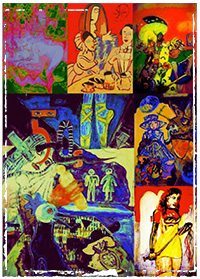By Jacob Koster
This year’s PGR Studio conference was a great success. For the first time, the conference was open to contributions from outside ADM, giving postgraduate students across BCU the opportunity to engage in fruitful academic exchange. Topics ranged from community-based art to GCSE English policy, and from indigenous music in Ecuador to ceramic roofing tiles in Beijing. We also had an interactive workshop prepared by our very own Yasmin Boyle (a member of the steering committee), which involved participants getting intimate with a furry sculpture.
As a member of the steering committee, I was involved in the planning and execution of the conference. In this blog post, I would like to share my reflections on the keynote address, which closely followed the conference theme. I hope my contribution will spark a discussion about some of the more controversial questions raised by this year’s conference. I encourage panellists and participants to respond with their own reflections.
This year’s keynote was delivered by Dr Karen Patel, director of the Centre for Equality, Diversity and Inclusion in the Arts (CEDIA). Karen’s talk was about racism in professional knitting. In 2018, knitters began to draw attention to the community’s lack of diversity. This prompted a series of debates, most of which took place on social media. Karen conducted interviews with participants in these debates and analysed social media posts, focusing on the experience of craftswomen of colour. What she found was evidence of racism and ‘microaggressions’. She gave us several examples: a man complimenting a woman on her ‘beautiful oriental eyes’, another commenting on a woman’s Native American earrings. Karen also mentioned a white craftswoman who was so thrilled to go to India that she compared it to ‘being offered a seat on a flight to Mars’. Predictably, this generated a social media backlash, with many finding the comment exoticizing. Some of Karen’s examples were more serious but also more ambiguous, such as people of colour feeling ignored in yarn stores. There were a few examples of outright racism (‘we don’t want brown people here’), but these were the exception. Karen also highlighted the ‘emotional labour of calling out racism’ and its adverse effects on mental health.
Karen’s presentation had piqued my curiosity. When I got home I decided to read up on the ‘racism in knitting debates’ myself. What I discovered is that the ‘debates’ were actually a major controversy. In 2018 a high-profile knitter created the hashtag #diversknitty, which quickly went viral. The idea was to promote underrepresented groups and create a more inclusive community – laudable goals. However, things quickly got out of hand. What began as a praiseworthy attempt to make knitting more inclusive degenerated into an online free-for-all. When the knitter who started the debates noticed that his hashtag was being used to shame and discredit people, he tried to intervene. In the eyes of some, this made him a racist too – or, if not a racist, an apologist for racism. After weeks of online vitriol, he became suicidal and was rushed to hospital. He had fallen victim to the wave of indignation he himself had unleashed. Others were attacked for refusing to participate in the witch-hunt. This, too, was interpreted as a sign of guilt. In short, the ‘racism in knitting debates’ saw some of the worst excesses of cancel culture. It caught the attention of several media outlets, including the BBC, which devoted a radio broadcast to it (featuring BCU’s Kehinde Andrews).
I feel compelled to mention these facts because they were so conspicuously absent from Karen’s presentation. Their inclusion could have led to a more complex discussion in which ‘good’ and ‘bad’ aren’t so neatly parcelled out. One of the questions Karen’s presentation raised for me concerns the kind of diversity that is being promoted, and whether this diversity doesn’t in fact conceal a deep homogeneity. When I trawled through the reactions provoked by the ‘flight to Mars’ comment, I discovered that many people – including people of colour – did not find the comment offensive, let alone racist, or did find it offensive but deemed the backlash disproportionate. Similarly, there were people – including people of colour – who argued that the supposed underrepresentation of minorities was severely exaggerated. However, those voices did not figure in Karen’s case study. Why? Are they so obviously wrong that they should be ignored? Or are they simply at odds with Karen’s political views?
The fact is that one’s opinions about questions of race and identity often spring from one’s political convictions. For instance, the far left and conservatives are united in their opposition to liberal identity politics. When black socialists and black conservatives reject the notion that racism is the number one problem facing society, should they be ignored, ‘deplatformed’, or cancelled? Indeed, the trend in professional and academic life is to exclude such viewpoints in the name of diversity. It should be clear that this appears to them not as the selfless defence of marginalized communities but rather the opposite: censorship of those – including minorities – with the ‘wrong’ opinions. This reveals an uncomfortable truth about the champions of diversity: they are interested in marginalized groups only insofar as they toe the ‘correct’ political line. Diversity is a front for something else: an attempt to enforce ideological consensus – a point made with considerable elegance by Chimamanda Ngozi Adichie.
If we are truly interested in diversity, we should strive to represent different political viewpoints too. I worry when contentious issues are presented as self-evident or when partisan positions are expected to meet with general assent. In this sense, Karen’s presentation revealed one of the paradoxes of diversity discourse: the unanimity with which it is received. Her presentation did not encounter any resistance; everyone in the audience seemed to agree with her. But this tells us little about its validity. Rather, it tells us something about the striking lack of diversity in the audience.




